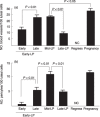Angiogenesis in the human corpus luteum
- PMID: 29699289
- PMCID: PMC5904659
- DOI: 10.1111/j.1447-0578.2008.00205.x
Angiogenesis in the human corpus luteum
Abstract
Angiogenesis is important for the formation and development of the corpus luteum and for maintenance of luteal function. Blood vessel regression is an important physiological phenomenon in the corpus luteum, which is associated with tissue involution during structural luteolysis. Angiogenesis actively occurs during the early luteal phase and is completed by the mid-luteal phase. Perivascular cells (pericytes) increase in number from the early luteal phase to the mid-luteal phase, suggesting that blood vessels are gradually stabilized until the mid-luteal phase. In the corpus luteum undergoing luteolysis, blood vessels and pericytes decrease in number, which is related to structural involution. In the corpus luteum of early pregnancy, the number of blood vessels with pericytes increases, suggesting that angiogenesis occurs again, accompanied by blood vessel stabilization. These changes in vasculature of the corpus luteum are regulated by the collaboration with vascular endothelial growth factor, which is involved in proliferation of vascular endothelial cells, and angiopoietins, which are involved in stabilization of blood vessels. This review focuses on angiogenesis, blood vessel stabilization and blood vessel regression during the divergent phases of luteal formation, luteal regression and luteal rescue by pregnancy. (Reprod Med Biol 2008; 7: 91-103).
Keywords: angiogenesis; angiopoietin; blood flow; corpus luteum; vascular endothelial growth factor.
Figures




References
-
- Tamura H, Greenwald GS. Angiogenesis and its hormonal control in the corpus luteum of the pregnant rat. Biol Reprod 1987; 36: 1149–1154. - PubMed
-
- Ferrara N, Chen H, Davis‐Smyth T et al Vascular endothelial growth factor is essential for corpus luteum angiogenesis. Nat Med 1998; 4: 336–340. - PubMed
-
- Fraser HM, Dickson SE, Lunn SF et al Suppression of luteal angiogenesis in the primate after neutralization of vascular endothelial growth factor. Endocrinology 2000; 141: 995–1000. - PubMed
-
- Sugino N, Kashida S, Takiguchi S, Karube A, Kato H. Expression of vascular endothelial growth factor and its receptors in the human corpus luteum during the menstrual cycle and in early pregnancy. J Clin Endocrinol Metab 2000; 85: 3919–3924. - PubMed
-
- Kashida S, Sugino N, Takiguchi S et al Regulation and role of vascular endothelial growth factor in the corpus luteum during mid‐pregnancy in rats. Biol Reprod 2001; 64: 317–323. - PubMed
Publication types
LinkOut - more resources
Full Text Sources
